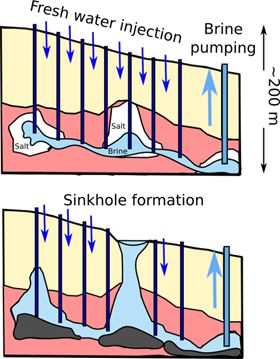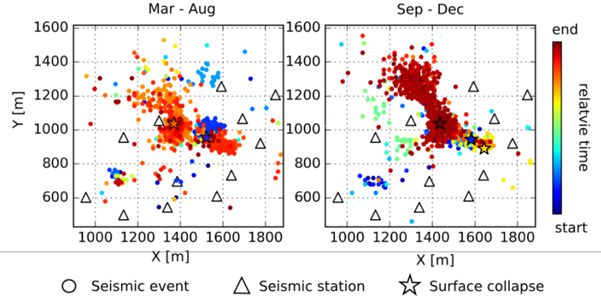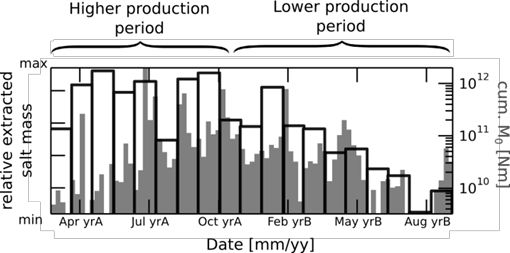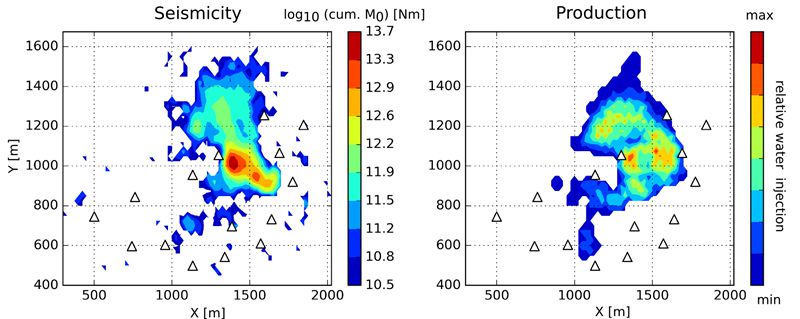
Case study of real-time microseismic monitoring of solution mines prone to ground collapses
INERIS performs a routine application of automatic near-to-real time microseismic monitoring of solution mining cavities to detect and locate microseismic swarms, and identify potential areas of sudden surface collapse. It has been successfully integrated into an early warning system implemented on an active brine field, where the geometry of the solution cavities is unknown, bringing major outcomes in terms of safety achievements, mine planning and land use
Context.
Solution extraction of soluble minerals such as salt entails the creation of underground cavities, injecting fresh water into the salt to dissolve it, and then recovering brine. Depending on the geological conditions, a number of these cavities can result in localized land-surface subsidence and sinkhole formation. As these phenomena can happen very rapidly, they present a pervasive threat to miners and a high potential for environmental damages.Site description.
In this active brine field site located out of France, the salt deposit occurs in heterogeneously distributed lenses at varying depth, over an area of several km2. The site is equipped with a surface microseismic network that is technically managed by the mine operator while INERIS provides near-to-real time data processing capabilities as well as early warning services.
Scheme of production procedure and potential sinkhole creation
Solution.
The data flow from the field monitoring network is transferred to INERIS monitoring Center, in France, according to a secure communication protocol that allows also remote control of the system. The data is then managed through the cloud monitoring infrastructure e.cenaris. First, an automatic event detection and classification approach has been implemented to distinguish microseismic events from noise related to exploitation, such as pumping, trucks, etc., thunder/lightening and regional tectonic earthquakes. Second,a fully automatic amplitude based location approach has been implemented to deal with low signal-to-noise ratios (resulting from strong local attenuation effects, low energetic events and strong surface seismic noise related to local exploitation). Third, an estimation of the seismic source sizes is integrated in the data processing tool by calculating the seismic source with the seismic moment, Mo.Results.
Several local sinkhole events could be anticipated within a few weeks or days before collapse was observed at surface, allowing the mine staff to take preventive safety decisions. It is likely, that these events have been provoked by increased production rate, what generally increased the potential to build underground cavities, sufficiently large in size to propagate to surface.
Example of sinkhole formations (stars) and associated seismic activity (points)
Microseismicity is mainly related to caving processes in the overburden and can be used as an indirect measure of the total cavity size. Accordingly, seismic source volume (cumulative Mo) is generally proportional to the total extracted salt mass. In addition, the spatial distribution of the seismic source volume and fresh water injection volumes are in very good agreement. This good spatial fit indicates that solution and caving processes proceed in a controlled manner, i.e. that solution processes are focused on those injection wells where most fresh water is injected.

Cumulative seismic moment Mo (gray bars) shown as a function of time compared to the mass of extracted salt

Spatial distribution of seismicity (a) and active fresh water injection wells (b)
Lesson learned.In this complex environment composedof operating and abandoned wells and cavities of unknown geometries, microseismic monitoring has become a new tool to identify possible situations of uncontrolled dissolution.